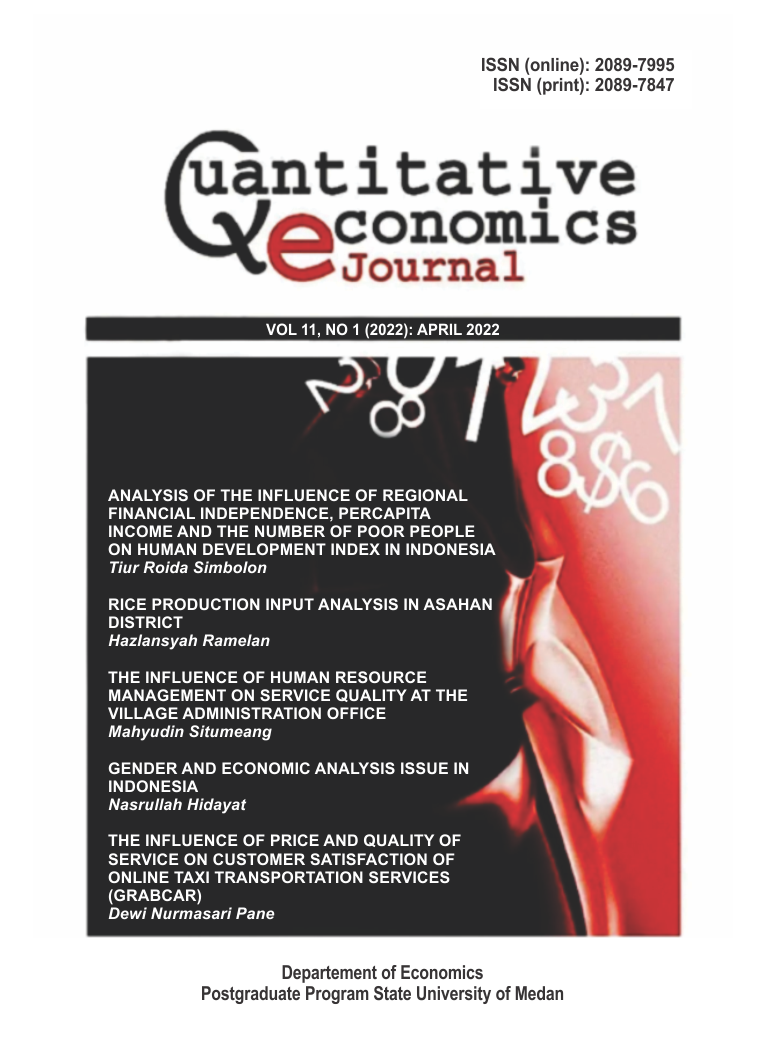ANALYSIS OF THE INFLUENCE OF REGIONAL FINANCIAL INDEPENDENCE, PERCAPITA INCOME AND THE NUMBER OF POOR PEOPLE ON HUMAN DEVELOPMENT INDEX IN INDONESIA
DOI:
https://doi.org/10.24114/qej.v11i1.36346Abstract
The human development index is an important indicator to measure success in efforts to build human quality of life. Human development emphasizes the fulfillment of a life worthy of man. The government is making efforts to improve the quality of the population as a resource, both from aspects of education such as subsidies contained in the law, in terms of health and economic perspectives that can be seen from the income of the community. In this study, the authors analyzed how the influence of regional financial independence, percapita income and the number of poor people as an effort in the process of improving human development in each province in Indonesia. The research data was taken from 34 provinces in Indonesia with a period from 2014-2018 through the Central Statistics Agency. Through chow test and hausman test, this study used panel data analysis with Fixed Effect Model (FEM) approach. The results of partial or t-tests showed that regional financial independence had a significant effect on the human development index with a statistical t-value of 3,100864 and a probability of α < 0.05, Per capita GDP data has a significant effect on the human development index with a statistical t-value of 5,131457 and a probability of α < 0.05, and the number of poor people has a significant effect on the human development index with a statistical t-value of -16,10742 and a probability of α < 0.05. Simultaneous test results or F-test showed a statistical F-value of 74,08607 with a probability of α < 0.05 which means that together independent variables have a significant effect on dependent variables. Through the R² test results obtained a value of 0.952502 means variables of regional financial independence, percapita income and the number of poor people are able to explain the effect on the human development index in each province in Indonesia by 95 percent ____________________________________________________________Keywords: Regional Financial Independence (KKD), Perkapita Income (GDPperkapita), Number of Poor People (JPM), Human Development Index (HDI), Fixed Effect Model (FEM)References
BPS.(2018).Indonesia Dalam Angka.Indonesia:BPS
Baeti, Nur.(2013).Pengaruh Pengangguran, Pertumbuhan Ekonomi dan Pengeluaran Pemerintah Terhadap Pembangunan Manusia Kabupaten/Kota di Provinsi Jawa Tengah.Volume 2 Nomor 3.Economics Development Analysis Journal.
Daniela, Neamtu dan Mihaela. (2015). Correlations Between Human Development and Economic Growth.Issue 1 Vol.1. Academia Brancusi Publisher.
Dewi, Novita. (2017). Pengaruh Kemiskinan dan Pertumbuhan Ekonomi Terhadap Indeks Pembangunan Manusia di Provinsi Riau. Volume 4 Nomor 1.Jurnal JOM Fekon.
Ginting, dkk. (2008). Pembangunan Manusia di Indonesia dan Faktor-Faktor Yang Mempengaruhinya.Volume 4 Nomor 1.Jurnal Perencanaan dan Pengembangan Wilayah.
Gousario, Freska and Christiana Fara Dharmastuti.(2015).Regional Financial Performance and Human Development Index Based On Study in 20 Counties/Cities of Level I Region. Vol.16 Nomor 2.Journal The Winners.
Jhingan, M.L. (1996). Ekonomi Pembangunan dan Perencanaan.Jakarta:PT. Raja Grafindo Persada.
Hukom, Alexandra. (2015). Effect Of Capital Expenditure, Economics Growth And Poverty on Human Development In Central Kalimantan.Vol.6 Issue 6.IOSR Journal of Economics and Finance.
Kanbur, Ravi and Lyn Squire. (1999).The Evolution Of Thinking About Poverty: Exploring Interactions.http://kanbur.dyson.cornell.edu/papers.htm
Kuncoro, Mudrajat. (2003). Ekonomi Pembangunan : Teori, Masalah dan Kebijakan.Yogyakarta : UPP AMP YKPN.
______________.2006.Ekonomika Pembangunan Edisi Keempat. Yogyakarta : UPP AMP YKPN.
Lumbantoruan, Eka P.(2014).Analisis Pertumbuhan Ekonomi dan Indeks Pemabngunan Manusia (IPM) Provinsi-Provinsi di Indonesia (Metode Kointegrasi).Volume 2 Nomor 2.Jurnal Ekonomi dan Keuangan.
Maqin, R. Abdul dan Iwan Sidharta.(2017). The Relationship Of Economic Growth with Human Development and Electricity Consumption in Indonesia.Vol. 7 Nomor 3. International Journal Of Energy Economics and Policy.
Mutia, Arthaingan H. (2018). The Effect of Financial Ratio to Human Development Index (Based on the Study in Districts and Cities of West Java).KnE Social Sciences.
Nugraha & Tia Amelia. (2017). Pengaruh Dana Perimbangan dan Kemandirian Daerah Terhadap Kesejahteraan Masyarakat pada Kabupaten/Kota di Jawa Barat.Volume 20 Nomor 1.Jurnal Wacana Kerja.
Nursiah Chalid dan Yusbar Yusuf. (2014). Pengaruh Tingkat Kemiskinan, Tingkat Pengangguran dan Upah Minimum Kabupaten/Kota dan Laju Pertumbuhan Ekonomi Terhadap Indeks Pembangunan Manusia di Provinsi Riau.Volume 22 Nomor 2.Jurnal Ekonomi
Orocomma, Manasep. B.Elita Bharanti., dan Paulus K. Allo Layuk.2017. Faktor-faktor yang Mempengaruhi Kemandirian Daerah Kabupaten Teluk Bintuni.Volume 2 Nomor 3.Jurnal Keuda.
Ranis, Gustav.2000.Economic Growth and Human Develoopment.Vol.28 Nomor 2.World Development.
Riphat, et al.2016.Causality Analysis Between Financial Performance and Human Development Index: A Case study Of Provinces In Eastern Indonesia. Vol.20 Nomor 3.Kajian Ekonomi dan Keuangan.
Subandi.2012.Ekonomi Pembangunan.Bandung:Alfabeta.
Sugiyono, Prof. Dr.2015.Metode Penelitian dan Pengembangan.Bandung:CV. Alfabeta.
Supartoyo, Yesi.2013.The Economic Growth and The regional Characteristics: The Case of Indonesia.Economics Development Analysis Journal.
Undang-Undang Nomor 23 tahun 2014 tentang Pemerintah Daerah
Undang-Undang Nomor 32 tahun 2004 tentang Pemerintah Daerah
Undang-Undang Nomor 25 tahun 1999 tentang Perimbangan Keuangan antara Pemerintah Pusat dan Daerah
Undang-Undang Nomor 33 tahun 2004 tentang Perimbangan Keuangan antara Pemerintah Pusat dan Daerah
http://www.bappenas.go.id
http://www.bps.go.id
http://www.djpk.kemenkeu.go.id












